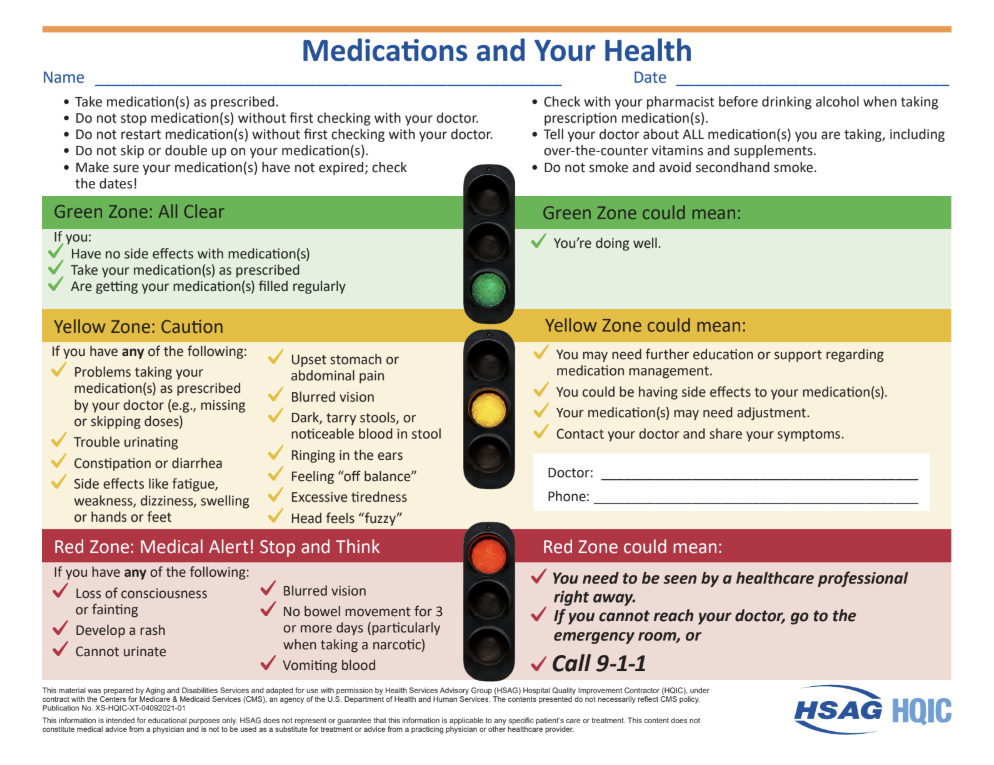Taking medications as prescribed is critical for managing your health, but it’s equally important to monitor how your body reacts to them. This simple, easy-to-understand Traffic Light System serves as your personal safety guide, helping you quickly identify when your medication routine is on track (Green), when you need to be cautious and seek advice (Yellow), and when a medical emergency is developing (Red). Use this guide to empower yourself and ensure ongoing communication with your healthcare team.

💊 Medications and Your Health: The Safety Guide
This guide uses a simple traffic light system to help you manage your medications and recognize when to seek medical help.
✅ General Rules for Safe Medication Use
- Take medication(s) exactly as prescribed.
- Do not stop medication(s) without first checking with your doctor.
- Do not restart medication(s) without first checking with your doctor.
- Do not skip or double up on your medication(s).
- Make sure your medication(s) have not expired; check the dates!
- Check with your pharmacist before drinking alcohol when taking prescription medication(s).
- Tell your doctor about ALL medication(s) you are taking, including over-the-counter vitamins and supplements.
- Do not smoke and avoid secondhand smoke.
🟢 Green Zone: All Clear (Good Status)
| What You Should Be Doing | What This Zone Means |
| * Have no side effects with medication(s) | * You’re doing well. |
| * Take your medication(s) as prescribed | |
| * Are getting your medication(s) filled regularly |
🟡 Yellow Zone: Caution (Seek Advice)
If you have any of the following symptoms or situations, you are in the Yellow Zone.
⚠️ Symptoms (The “Off” Signals)
- Digestive Issues: Upset stomach or abdominal pain, constipation or diarrhea.
- Urinary/Fluid Issues: Trouble urinating, swelling or fullness in hands or feet.
- Sensory/Vision Issues: Blurred vision, dark, tarry, sool, or noticeable blood in stool, ringing in the ears.
- Energy/Mental State: Fatigue, weakness, excessive tiredness, feeling “off balance,” head feels “fuzzy.”
- Side Effects: Side effects like fatigue, weakness, dizziness, or swelling.
🛑 Situations (The “Missing” Signals)
- Problems taking your medication(s) as prescribed by your doctor (e.g., missing or skipping doses).
| What This Zone Means | Recommended Action |
| * You may need further education or support regarding medication management. | Contact your doctor and share your symptoms. |
| * You could be having side effects to your medication(s). | (You may need a medication adjustment.) |
| * Your medication(s) may need adjustment. |
🔴 Red Zone: Medical Alert! (Stop and Think)
If you have any of the following symptoms, you are in the Red Zone.
- Loss of consciousness or fainting.
- Develop a rash.
- Cannot urinate.
- Blurred vision.
- No bowel movement for 3 or more days (particularly when taking a narcotic).
- Vomiting blood.
| What This Zone Means | Recommended Action |
| * You need to be seen by a healthcare professional right away. | * If you cannot reach your doctor, go to the emergency room, or |
| * CALL 9-1-1 |
🛑 Disclaimer
This material was prepared by the Aging and Disabilities Services and adapted for use with permission by Health Services Advisory Group (HSAG) Hospital Quality Improvement Contractor (HQIC), under contract with Centers for Medicare & Medicaid Services (CMS). This guide is for educational purposes only and is not meant to replace the advice of a physician or other healthcare provider. HSAG does not represent or guarantee that this information is applicable to any specific patient’s care or treatment. Always consult your physician before making any changes to your medication regimen.
📚 Source
This content is adapted from educational materials originally published by the Health Services Advisory Group (HSAG) Hospital Quality Improvement Contractor (HQIC).
- Urinary Health Zones: A Simple Guide to Symptoms
- Medication Safety Guide: Use the Traffic Light System to Manage Your Health
- Pneumonia Self-Management Plan: Monitor Symptoms & Know When to Seek Help
- Social Isolation and Loneliness in Older Adults: What the Health Care System Can Do
- Managing Multiple Chronic Conditions in Older Adults: A Practical Guide for Families & Care Teams


